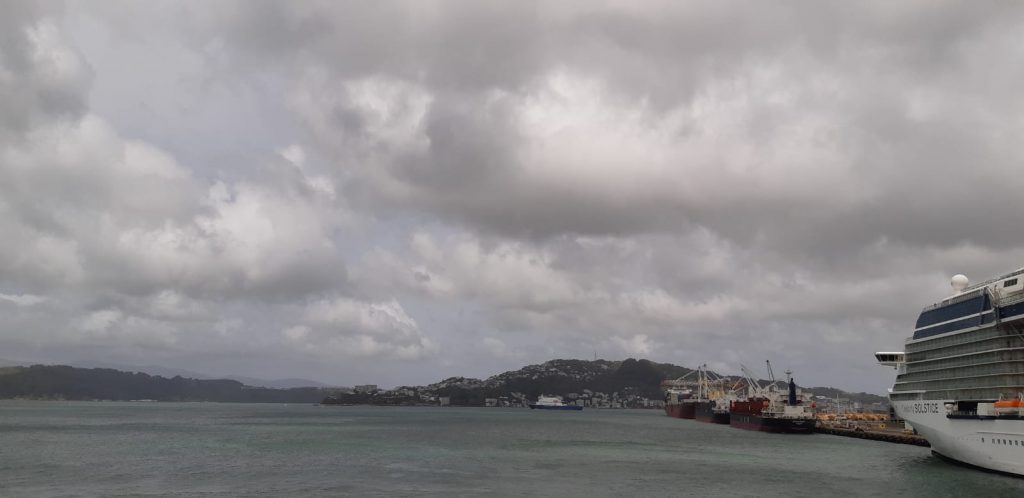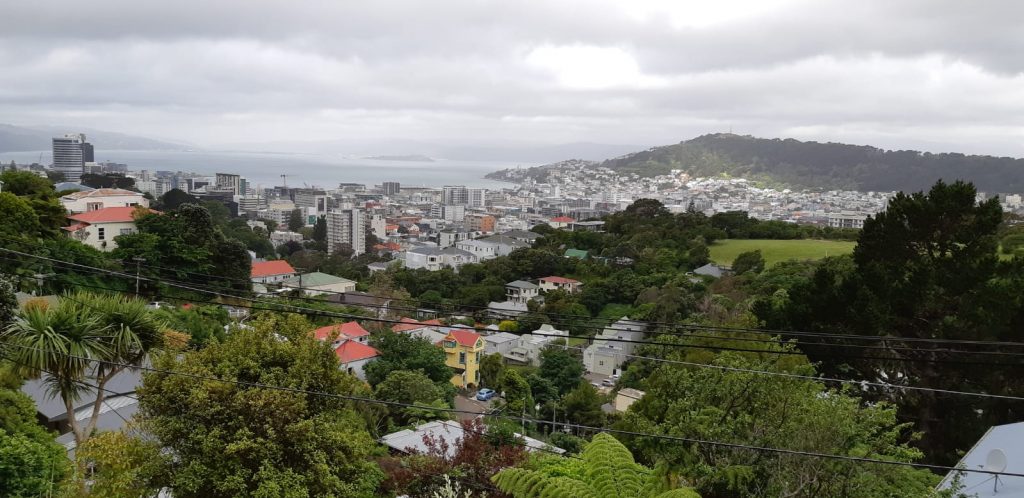We met our son (whom we had not seen for 2 ½ years, as he had spent 1 year in Australia and then 1 year in New Zealand) in Wellington. He drove us through the hilly streets to our accommodation. The evening was spent as a family, catching up on everything.

Wellington is the capital and political centre of New Zealand, with a population of 215,100 (2020), but the greater Wellington area has a population of 436,000 people who live on a surface of 444 km². Only Auckland to the north of the North Island is bigger. It was the nation’s capital until 1865 when it was transferred to Wellington. It was seen to be more appropriate to have the capital in the centre of the country, on the Cook Straits. The city was named after the first Duke of Wellington, who won the Battle of Waterloo in 1815.
European colonisation started in 1839. The area was swampland. The original settlement was in Petone, on the Hutt River but the ground proved to be unsuitable because it was inundated with water. Another settlement was built in Thornton, now the harbour of Wellington.
In Māori Language, Wellington has two names. The first is Te Whanganui-A-Tara (which comes from the name of the harbour and means ‘The big harbour of Tara”. The second name is Poneke which is a phonetic translation from another surname of Port Nicholson.
The weather is extremely windy, which can really affect your arrival or departure from the city. Delays due to the weather are common. The climate is an oceanic climate. The average temperature in Summer (Dec – Feb) is on average 20°, with rainfall of about 72 mm. In the winter, the temperatures are about 11° with precipitation of around 135 mm.
There are many museums, a rich café culture, and vibrant nightlife, which other cities in New Zealand dream of. It is the centre of the NZL film industry. The WETA Studios of Peter Jackson are in Wellington (Home of Lord of the Rings, King Kong, and Avatar).
It also boasts a lively theatre scene and has the National Museum, Te Papa Tongarewa. For music lovers, there is the National Symphony Orchestra and the New Zealand National Ballet.
Wellington offers a good quality of life. It is listed 13th on the Mercer index. Because everything has to be imported, NZL is quite expensive, but Wellington is the cheapest city for tourists to stay in.
There were major earthquakes in 1848 and 1855, with a magnitude estimated at 8.2 on the Richter scale. There was a major vertical shift of tectonic plates of between 2-3 meters. The whole region is known for its seismic activity. The town is built on a major fault line.
The city is very hilly, and the streets are quite steep, resulting from the poor quality of the ground.

We arrived on a cold grey day, now in mid-November in late Spring. It was very windy.
We decided not to spend too much time in Wellington, so the next day we began to discover the North Island. This time, we did not use buses, we drove by car. It was an easier way to travel. We could be more flexible, but not so carbon-neutral.
Manuka honey
It is produced for just a few weeks of the year. Honeybees gather the nectar from the Manuka tree which is native to NZL (Leptospermum scoparium). They return to their hives to create this incredible and distinctive honey. Manuka has a long history as a respected medicinal plant, traditionally used as a remedy by the Māoris. The special qualities come from the manuka flower nectars, which contribute unique natural compounds which make the honey so different from other kinds of honey.
The benefits are that it is filled with antioxidants. It benefits the heart, and the most important aspect is that it can heal burn wounds and other skin conditions. It is also used to reduce coughing and ease digestive problems.
If you can afford it, you can also have it on your toast for breakfast. New Zealand produces other honey such as Clover, Kamahi, Rata, and other native bush varieties. The classification is UMF (Unique Manuka Factor). The lower the number, the less Leptosperin which is a chemical compound found in Manuka honey nectar that has anti-inflammatory properties. The higher the content, the more powerful anti-inflammatory effects it has. The most powerful Manuka honey exceeds 200 mg/kg of leptospira.
